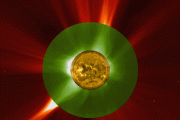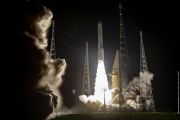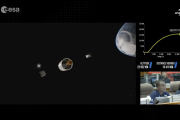
Copernical Team
Inauguration of mainland Europe's first satellite launch complex
 On 13 January 2023, the Swedish head of state, King Carl XVI Gustaf, together with European and Swedish political dignitaries will visit Esrange Space Center in northern Sweden to cut the ribbon of a new spaceport that will significantly reshape the European space landscape. After years of preparation and construction, European mainland's first orbital launch complex, Spaceport Esrange, will be
On 13 January 2023, the Swedish head of state, King Carl XVI Gustaf, together with European and Swedish political dignitaries will visit Esrange Space Center in northern Sweden to cut the ribbon of a new spaceport that will significantly reshape the European space landscape. After years of preparation and construction, European mainland's first orbital launch complex, Spaceport Esrange, will be Virgin Orbit' Launcherone Systems given green light for upcoming mission
 The U.K. Civil Aviation Authority has issued launch and range control licenses to Virgin Orbit (Nasdaq: VORB) to undertake the first satellite launch from UK soil. The granting of these licenses represents a major step forward for the historic Start Me Up mission, and reflects the CAA's concurrence that all reasonable steps have been taken by Virgin Orbit to ensure the desired safety, security,
The U.K. Civil Aviation Authority has issued launch and range control licenses to Virgin Orbit (Nasdaq: VORB) to undertake the first satellite launch from UK soil. The granting of these licenses represents a major step forward for the historic Start Me Up mission, and reflects the CAA's concurrence that all reasonable steps have been taken by Virgin Orbit to ensure the desired safety, security, Three time dimensions, one space dimension
 How would our world be viewed by observers moving faster than light in a vacuum? Such a picture would be clearly different from what we encounter every day. We should expect to see not only phenomena that happen spontaneously, without a deterministic cause, but also particles traveling simultaneously along multiple paths - argue theorists from universities in Warsaw and Oxford.
Also the ve
How would our world be viewed by observers moving faster than light in a vacuum? Such a picture would be clearly different from what we encounter every day. We should expect to see not only phenomena that happen spontaneously, without a deterministic cause, but also particles traveling simultaneously along multiple paths - argue theorists from universities in Warsaw and Oxford.
Also the ve New study models the transmission of foreshock waves towards Earth
 An international team of scientists led by Lucile Turc, an Academy Research Fellow at the University of Helsinki and supported by the International Space Science Institute in Bern has studied the propagation of electromagnetic waves in near-Earth space for three years. The team has studied the waves in the area where the solar wind collides with Earth's magnetic field called foreshock region, an
An international team of scientists led by Lucile Turc, an Academy Research Fellow at the University of Helsinki and supported by the International Space Science Institute in Bern has studied the propagation of electromagnetic waves in near-Earth space for three years. The team has studied the waves in the area where the solar wind collides with Earth's magnetic field called foreshock region, an New technique reveals changing shapes of magnetic noise in space and time
 Electromagnetic noise poses a major problem for communications, prompting wireless carriers to invest heavily in technologies to overcome it. But for a team of scientists exploring the atomic realm, measuring tiny fluctuations in noise could hold the key to discovery.
"Noise is usually thought of as a nuisance, but physicists can learn many things by studying noise," said Nathalie de Leon,
Electromagnetic noise poses a major problem for communications, prompting wireless carriers to invest heavily in technologies to overcome it. But for a team of scientists exploring the atomic realm, measuring tiny fluctuations in noise could hold the key to discovery.
"Noise is usually thought of as a nuisance, but physicists can learn many things by studying noise," said Nathalie de Leon, Moon water imager integrated with NASA's Lunar Trailblazer
 JPL's cutting-edge instrument, which will provide insights into the lunar water cycle and composition of the Moon's surface, has been incorporated into the small satellite. Lunar Trailblazer, NASA's mission to understand lunar water and the Moon's water cycle led by Caltech in Pasadena, California, is one step closer to launching next year. Earlier this month, the agency's Jet Propulsion Laborat
JPL's cutting-edge instrument, which will provide insights into the lunar water cycle and composition of the Moon's surface, has been incorporated into the small satellite. Lunar Trailblazer, NASA's mission to understand lunar water and the Moon's water cycle led by Caltech in Pasadena, California, is one step closer to launching next year. Earlier this month, the agency's Jet Propulsion Laborat HAARP to bounce signal off asteroid in NASA experiment
 An experiment to bounce a radio signal off an asteroid on Dec. 27 will serve as a test for probing a larger asteroid that in 2029 will pass closer to Earth than the many geostationary satellites that orbit our planet.
The High-frequency Active Auroral Research Program research site in Gakona will transmit radio signals to asteroid 2010 XC15, which could be about 500 feet across. The Univer
An experiment to bounce a radio signal off an asteroid on Dec. 27 will serve as a test for probing a larger asteroid that in 2029 will pass closer to Earth than the many geostationary satellites that orbit our planet.
The High-frequency Active Auroral Research Program research site in Gakona will transmit radio signals to asteroid 2010 XC15, which could be about 500 feet across. The Univer InSight goes silent as Martian dust and cold ends mission
 The InSight Mars mission is history. On 20 December 2022, NASA declared the mission over. The two attempts from Mission Control Centre at NASA's Jet Propulsion Laboratory (JPL) in Southern California to reach the lander via relay satellites in Mars orbit have been unsuccessful. This almost certainly means that InSight's solar-powered batteries are no longer supplying enough power, a condition en
The InSight Mars mission is history. On 20 December 2022, NASA declared the mission over. The two attempts from Mission Control Centre at NASA's Jet Propulsion Laboratory (JPL) in Southern California to reach the lander via relay satellites in Mars orbit have been unsuccessful. This almost certainly means that InSight's solar-powered batteries are no longer supplying enough power, a condition en No oxygen required to make these minerals on Mars
 When NASA's Mars rovers found manganese oxides in rocks in the Gale and Endeavor craters on Mars in 2014, the discovery sparked some scientists to suggest that the red planet might have once had more oxygen in its atmosphere billions of years ago.
The minerals probably required abundant water and strongly oxidizing conditions to form, the scientists said. Using lessons learned from Earth's
When NASA's Mars rovers found manganese oxides in rocks in the Gale and Endeavor craters on Mars in 2014, the discovery sparked some scientists to suggest that the red planet might have once had more oxygen in its atmosphere billions of years ago.
The minerals probably required abundant water and strongly oxidizing conditions to form, the scientists said. Using lessons learned from Earth's NASA explores a winter wonderland on Mars
 When winter comes to Mars, the surface is transformed into a truly otherworldly holiday scene. Snow, ice, and frost accompany the season's sub-zero temperatures. Some of the coldest of these occur at the planet's poles, where it gets as low as minus 190 degrees Fahrenheit (minus 123 degrees Celsius).
Cold as it is, don't expect snow drifts worthy of the Rocky Mountains. No region of Mars g
When winter comes to Mars, the surface is transformed into a truly otherworldly holiday scene. Snow, ice, and frost accompany the season's sub-zero temperatures. Some of the coldest of these occur at the planet's poles, where it gets as low as minus 190 degrees Fahrenheit (minus 123 degrees Celsius).
Cold as it is, don't expect snow drifts worthy of the Rocky Mountains. No region of Mars g 
































